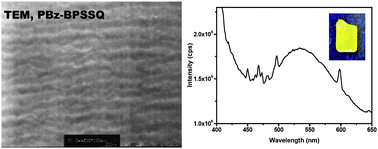A benzoxazine-bridged bis(triethoxysilane) compound (Bz-BES) has been prepared using bisphenol-A, paraformaldehyde, and 3-aminopropyltriethoxysilane as precursors. Characterization of Bz-BES has been conducted with Fourier transform infrared, nuclear magnetic resonance, molecular mass, and elemental analysis. Thermally cured polybenzoxazine-bridged polysilsesquioxane (PBz-BPSSQ) was obtained via the sol–gel and thermal treatment process of Bz-BES. PBz-BPSSQ shows a layer-by-layer lamellar structure composed of polybenzoxazine-rich and polysilsesquioxane-rich layers in the thickness of about 80–100 nm, resulting in its ultra-low dielectric constant of about 1.57 at 1 MHz. PBz-BPSSQ also displays a high glass transition temperature of about 295 °C and a Young's modulus of about 3.1 GPa, both are attributed to its highly cross-linked structure. Moreover, PBz-BPSSQ exhibits yellow-light photoluminescent emission at about 540 nm under excitation at 365 nm.
You have access to this article
 Please wait while we load your content...
Something went wrong. Try again?
Please wait while we load your content...
Something went wrong. Try again?


 Please wait while we load your content...
Please wait while we load your content...